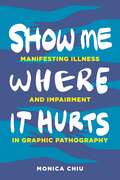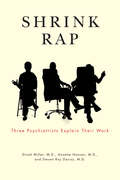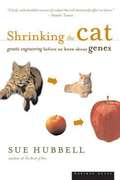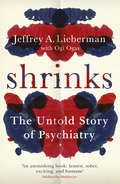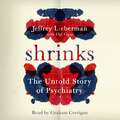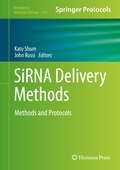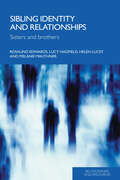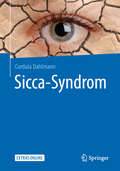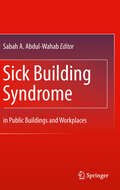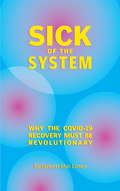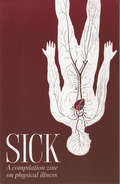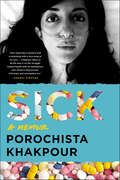- Table View
- List View
Shoulderology: Searching for "Whys" Related to the Shoulder
by Eiji ItoiThis Monograph is a compilation of clinical experience and basic research by the author on the function and anatomy of the shoulder joint, with particular emphasis on biomechanics. The book provides deep and comprehensive knowledge about the shoulder based on the author’s over forty years of career. This book is unique in that it emphasizes the process of discovering new knowledge through searching for clinical questions or “whys” and solving them. The author shows how he tackled various problems with a great deal of medical curiosity. The chapters place much space on anatomy, function, and pathology, for correct treatment through an accurate understanding of the pathology. The first part of this book explains the basic examination methods as clearly as possible, with abundant figures taken during patient consultations. Part two through four describes some diseases of the shoulder joint, including rotator cuff tears, instability, frozen shoulder, biceps disorders, and throwing shoulder, all of which are frequently encountered in daily practice. In part five, biomechanical research related to suture anchors is presented, and correct insertion angles and intervals are described. It is crucial to understand the surgical method correctly and question the commonly used techniques for better patient care. A clear explanation of long-standing debates, such as the deadman theory, is explained based on the evidence from his research. The last part presents two cases that are rarely encountered but are interesting from the perspective of functional reconstruction of the shoulder. Shoulderology - Searching for “Whys” Related to the Shoulder invites shoulder surgeons, fellows, residents, and medical students to read the thought-provoking collection of evidence and interpretations of the common knowledge. It will be of interest to orthopaedic surgeons specializing in other areas. The author places a strong emphasis on educating young researchers and provides valuable guidance apart from the basic research and clinical practice and hopes that the book will motivate the subsequent generations to pursue further study.
Show Me Where It Hurts: Manifesting Illness and Impairment in Graphic Pathography (Graphic Medicine)
by Monica ChiuIn Show Me Where It Hurts, Monica Chiu argues that graphic pathography—long-form comics by and about subjects who suffer from disease or are impaired—re-vitalizes and re-visions various negatively affected corporeal states through hand-drawn images. By the body and for the body, the medium is subversive and reparative, and it stands in contradistinction to clinical accounts of illness that tend to disembody or objectify the subject.Employing affect theory, spatial theory, vital materialism, and approaches from race and ethnic studies, women and gender studies, disability studies, and comics studies, Chiu provides readings of recently published graphic pathography. Chiu argues that these kinds of subjective graphic stories, by virtue of their narrative and descriptive strengths, provide a form of resistance to the authoritative voice of biomedicine and serve as a tool to foster important change in the face of social and economic inequities when it comes to questions of health and healthcare. Show Me Where It Hurts reads what already has been manifested on the comics page and invites more of what demands expression.Pathbreaking and provocative, this book will appeal to scholars and students of the medical humanities, comics studies, race and ethnic studies, disability studies, and women and gender studies.
Shrink Rap: Three Psychiatrists Explain Their Work
by Dinah Miller Annette Hanson Steven Roy DavissFinally, a book that explains everything you ever wanted to know about psychiatry!In Shrink Rap, three psychiatrists from different specialties provide frank answers to questions such as:• What is psychotherapy, how does it work, and why don't all psychiatrists do it?• When are medications helpful?• What happens on a psychiatric unit?• Can Prozac make people suicidal?• Why do many doctors not like Xanax?• Why do we have an insanity defense?• Why do people confess to crimes they didn't commit?Based on the authors' hugely popular blog and podcast series, this book is for patients and everyone else who is curious about how psychiatrists work. Using compelling patient vignettes, Shrink Rap explains how psychiatrists think about and address the problems they encounter, from the mundane (how much to charge) to the controversial (involuntary hospitalization). The authors face the field's shortcomings head-on, revealing what other doctors may not admit about practicing psychiatry. Candid and humorous, Shrink Rap gives a closeup view of psychiatry, peering into technology, treatments, and the business of the field. If you've ever wondered how psychiatry really works, let the Shrink Rappers explain.
Shrink Rap: Three Psychiatrists Explain Their Work
by MD Dinah Miller MD Annette Hanson MD Steven Roy Daviss“One of the most useful books I’ve read about mental illnesses . . . It demystifies our complicated medical and legal system.” —Pete Earley, New York Times-bestselling author of Crazy: A Father’s Search Through America’s Mental Health MadnessFinally, a book that explains everything you ever wanted to know about psychiatry!In Shrink Rap, three psychiatrists from different specialties provide frank answers to questions such as:• What is psychotherapy, how does it work, and why don’t all psychiatrists do it?• When are medications helpful?• What happens on a psychiatric unit?• Can Prozac make people suicidal?• Why do many doctors not like Xanax?• Why do we have an insanity defense?• Why do people confess to crimes they didn’t commit?Based on the authors’ hugely popular blog and podcast series, this book is for patients and everyone else who is curious about how psychiatrists work. Using compelling patient vignettes, Shrink Rap explains how psychiatrists think about and address the problems they encounter, from the mundane (how much to charge) to the controversial (involuntary hospitalization). The authors face the field’s shortcomings head-on, revealing what other doctors may not admit about practicing psychiatry.Candid and humorous, Shrink Rap gives a closeup view of psychiatry, peering into technology, treatments, and the business of the field. If you’ve ever wondered how psychiatry really works, let the Shrink Rappers explain.“A fascinating peek into the minds of those who study minds.” —The Washington Post“Most of us easily understand how to treat a broken arm, but a fractured psyche? That’s an entirely different matter. Or is it? This clear-headed presentation of psychiatric services and methods covers a lot of ground and achieves a conversational tone that’s both educational and entertaining.” —Baltimore Magazine
Shrinkage Estimation for Mean and Covariance Matrices (SpringerBriefs in Statistics)
by Hisayuki Tsukuma Tatsuya KubokawaThis book provides a self-contained introduction to shrinkage estimation for matrix-variate normal distribution models. More specifically, it presents recent techniques and results in estimation of mean and covariance matrices with a high-dimensional setting that implies singularity of the sample covariance matrix. Such high-dimensional models can be analyzed by using the same arguments as for low-dimensional models, thus yielding a unified approach to both high- and low-dimensional shrinkage estimations. The unified shrinkage approach not only integrates modern and classical shrinkage estimation, but is also required for further development of the field. Beginning with the notion of decision-theoretic estimation, this book explains matrix theory, group invariance, and other mathematical tools for finding better estimators. It also includes examples of shrinkage estimators for improving standard estimators, such as least squares, maximum likelihood, and minimum risk invariant estimators, and discusses the historical background and related topics in decision-theoretic estimation of parameter matrices. This book is useful for researchers and graduate students in various fields requiring data analysis skills as well as in mathematical statistics.
Shrinkage: Manhood, Marriage, and the Tumor That Tried to Kill Me
by Bryan BishopA New York Times bestseller!An Amazon Best Books of 2014 selection"If you're reading this, it means I'm already dead. Just kidding."In 2009, at thirty years old, Bryan Bishop's life was right on track. Known to millions as "Bald Bryan," the sidekick and soundman on the record-setting podcast, The Adam Carolla Show, his radio career was taking off. He was newly engaged. Then, he and his fiancée Christie were delivered a crushing blow when he was diagnosed with a brain stem glioma—an inoperable brain tumor. Suddenly Bryan's promising future was transformed into a grueling schedule of radiation and chemotherapy while facing his mortality. In this poignant narrative that is alternately heartbreaking and hysterical, Bishop shares the surreal experiences of writing his will with the bravado of a pulp novelist, taking chemo in a strip club, and (technically) the closest he ever got to achieving his lifelong dream of a threesome—when a physical therapist had to show his wife how to bathe him in the shower during his weakened state.Whether recounting his search for the most aggressive form of treatment, how radiation treatment jeopardized his ability to (literally) walk down the aisle or even smile for his wedding photos, or recalling the time his wife inadvertently drugged him in a pool in Maui, Bishop's inimitable voice radiates through his story.As the author celebrates how treatment shrunk his tumor and gave him a new lease on life, Shrinkage reveals the resilience of the human spirit—and the power of laughter—during even the darkest times.
Shrinking the Cat: Genetic Engineering Before We Knew About Genes
by Sue HubbellIn this timely and controversial work, Sue Hubbell contends that the concept of genetic engineering is anything but new, for humans have been tinkering with genetics for centuries. Focusing on four specific examples -- corn, silkworms, domestic cats, and apples -- she traces the histories of species that have been fundamentally altered over the centuries by the whims and needs of people.
Shrinks: The Untold Story of Psychiatry
by Jeffrey A. Lieberman Ogi OgasA world-renowned psychiatrist reveals the fascinating story of psychiatry's origins, demise and redemption. Psychiatry has come a long way since the days of chaining 'lunatics' in cold cells and parading them as freakish marvels before a gaping public. But, as Jeffrey Lieberman reveals in his extraordinary and eye-opening book, the path to legitimacy for 'the black sheep of medicine' has been anything but smooth. In SHRINKS, Dr Lieberman traces the field from its birth as a mystic pseudo-science through its adolescence as a cult of 'shrinks' to its late blooming maturity since the Second World War as a science-driven profession that saves lives. With fascinating case studies and portraits of the luminaries of the field, from Sigmund Freud to Eric Kandel, SHRINKS is a gripping and illuminating read. It is also an urgent call-to-arms to dispel the stigma surrounding mental illness and to start treating it as a disease rather than a state of mind.
Shrinks: The Untold Story of Psychiatry
by Jeffrey A. Lieberman Ogi OgasThe fascinating story of psychiatry's origins, demise, and redemption, by the former President of the American Psychiatric Association. Psychiatry has come a long way since the days of chaining "lunatics" in cold cells and parading them as freakish marvels before a gaping public. But, as Jeffrey Lieberman, MD, reveals in his extraordinary and eye-opening book, the path to legitimacy for "the black sheep of medicine" has been anything but smooth. In Shrinks, Dr. Lieberman traces the field from its birth as a mystic pseudo-science through its adolescence as a cult of "shrinks" to its late blooming maturity -- beginning after World War II -- as a science-driven profession that saves lives. With fascinating case studies and portraits of the luminaries of the field - from Sigmund Freud to Eric Kandel -- Shrinks is a gripping and illuminating read, and an urgent call-to- arms to dispel the stigma of mental illnesses by treating them as diseases rather than unfortunate states of mind.
Shrinks: The Untold Story of Psychiatry
by Jeffrey A. Lieberman Ogi OgasA world-renowned psychiatrist reveals the fascinating story of psychiatry's origins, demise and redemption. Psychiatry has come a long way since the days of chaining 'lunatics' in cold cells and parading them as freakish marvels before a gaping public. But, as Jeffrey Lieberman reveals in his extraordinary and eye-opening book, the path to legitimacy for 'the black sheep of medicine' has been anything but smooth. In SHRINKS, Dr Lieberman traces the field from its birth as a mystic pseudo-science through its adolescence as a cult of 'shrinks' to its late blooming maturity since the Second World War as a science-driven profession that saves lives. With fascinating case studies and portraits of the luminaries of the field, from Sigmund Freud to Eric Kandel, SHRINKS is a gripping and illuminating read. It is also an urgent call-to-arms to dispel the stigma surrounding mental illness and to start treating it as a disease rather than a state of mind.Read by Graham Corrigan(p) 2015 Hachette Audio
Si puede no vaya al médico: Las advertencias de un médico sobre la dramática medicalización de nuestra hipocondríaca sociedad
by Antonio Sitges-Serra¿Paciente o cliente? Este provocador libro sobre la dramática medicalización de nuestra hipocondríaca sociedad pone al descubierto las prioridades insospechadas del sistema sanitario. La medicina, el antiguo y noble arte de curar cuyos poderes la ciencia moderna parece haber ampliado más allá de todo límite, se ha convertido en el siglo XXI en un enorme negocio con incalculables márgenes de beneficio, cuyos riesgos corren a cuenta, casi por entero, de quienes necesitan su atención: los pacientes. En el actual contexto cultural y socioeconómico, determinado por la alianza del capitalismo con la técnica, quien va al médico encuentra no sólo un profesional, sino todo un sistema sanitario cuya prioridad no es necesariamente su salud. ¿Paciente o cliente? Tanto la medicina pública como la privada padecen las consecuencias de la tecnolatría, el afán de lucroy la sed de prestigio que hoy se interponen entre el médico y quien lo consulta. Antonio Sitges-Serra, exJefe de Cirugía del Hospital del Mar de Barcelona, examina la medicina actual desde una perspectiva humanista que revela, bajo la utopía tecno-científica, un sistema insano que urge cambiar. «Este libro nos hace pensar, nos invita a actuar de otra manera y, sobre todo, arroja luz sobre lo que nos pasa, también en el alma. ¿Se le puede pedir más a un texto?»Manuel Cruz Reseñas:«El libro del prestigioso médico que receta no ir al médico.»Juan Soto Ivars, El Confidencial «Haríamos bien en escuchar voces tan autorizadas como la de Sitges-Serra.»Xavi Ayén, La Vanguardia «Una lectura profunda e interesante. No se pierdan este libro.»Julia Otero, Onda Cero
SiRNA Delivery Methods
by John Rossi Kato ShumThis volume provides a collection of cutting-edge strategies in siRNA delivery that were developed and refined over the years with tried-and-true methods. Written by a team of internationally renowned authors, this book describes, in detail, a variety of successful siRNA delivery methods, including peptide-based nanoparticles, liposomes, exosomes, polymers, aptamers, and viral vehicles. Written in the highly successful Methods in Molecular Biology series format, each proven protocol includes brief introductions to their respective topics, lists of the necessary materials and reagents, step-by-step, readily reproducible laboratory protocols, and tips on troubleshooting and avoiding known pitfalls. Comprehensive and authoritative, SiRNA Delivery Methods: Methods and Protocols, will provide researchers, educators, clinicians, and biotechnology specialists with a broad understanding of the issues in siRNA delivery and how they can be overcome strategically.
Sibling Identity and Relationships: Sisters and Brothers (Relationships and Resources)
by Rosalind Edwards Melanie Mauthner Lucy Hadfield Helen LuceySibling Identity and Relationships explores the special place that siblings occupy in the lives of children and young people, providing new insights into sibling identity and relationships. Drawing on social constructionist and psychodynamic perspectives, it discusses who constitutes a sibling, emotional connections and separations, conflict and aggression and how siblings construct and conduct their relationship out of the home, at school and in local communities. Shedding light on broader debates about social and psychic divisions in wider society, this book explores the ways that siblings are important for children and young people’s social and emotional sense of self in relation to others. Reviewing current literature on sibling relationships as well as proposing alternative theoretical perspectives, Sibling Identity and Relationships will be a valuable resource to academics and students of childhood studies and social work as well as health and social care professionals.
Sicca-Syndrom
by Cordula DahlmannDas Buch beleuchtet in prägnanter Form das Krankheitsbild der Keratokonjunktivitis sicca - auch Sicca-Syndrom genannt - , welches immer mehr in den Fokus von Forschung und Praxisalltag rückt. Die Ursachen für die Beschwerden des trockenen Auges sind komplex, der Leidensdruck der Betroffenen hoch. Hier setzt dieses Buch an: In kompakter, stichwortartiger Form bietet es eine praktische Orientierung zum diagnostischen und therapeutischen Management. Die klinischen Ursachen werden strukturiert beschrieben. Ein Vorschlag zur praktischen Testreihenfolge sowie 12 praxisnahe Falldarstellungen illustrieren die zielgerichtete Beratung und Therapie der Betroffenen. Eine Excel-Tabelle bietet einen Überblick über die gängigen Tränenersatzmittel und deren Eigenschaften und hilft damit, eine optimale Basistherapie für die unterschiedlichen Patienten zu finden. Individuelle Übersichten zum schnelleren Auffinden der passenden Produkte können mit Hilfe von Filterfunktionen erstellt werden. Die Tabelle steht zum Download und damit für den Gebrauch in der Beratung bereit. Ergänzende Methoden wie Akupunktur sowie psychosomatische Aspekte bieten erweiterte Methoden im therapeutischen Spektrum. Damit stellt dieses Buch eine praktische und übersichtliche Hilfe für Ärzte, Apotheker und Optiker zur optimalen Betreuung ihrer Patienten bzw. Kunden mit Sicca-Syndrom dar.
Sicherheitskultur im Rettungsdienst: Grundlagen zur Patienten- und Mitarbeitersicherheit
by Agnes Neumayr Adolf Schinnerl Michael Baubin Armin KrösbacherDie präklinische Notfallmedizin ist ein Hochrisikobereich. Sicherheitskultur und ein adäquates Risikobewusstsein sind demgemäß unumgänglich, um die Sicherheit der Patient:innen und Mitarbeitenden zu gewährleisten. Sicherheitskultur ist jedoch viel mehr als Risikomanagement. Sie beginnt in der Führungsebene und setzt eine Haltung voraus, in der wertschätzende Kommunikation, kollegiale Teamarbeit, der gerechte Umgang mit Fehlern oder die Förderung von Resilienz, Diversität und kollektiver Achtsamkeit im Mittelpunkt der Unternehmenskultur stehen sollen. Das Fachbuch behandelt die Grundlagen einer proaktiven Sicherheitskultur. Diskutiert werden neue Zugänge, Merkmale und Methoden der Sicherheitskultur sowie deren praktische Umsetzung in der präklinischen notfallmedizinischen Versorgung. Gesellschaftspolitische Herausforderungen, die durch die Digitalisierung der Lebens- und Arbeitswelten laufend neu entstehen, gehören genauso dazu, wie die Unsicherheiten durch die demographische Entwicklung, die Zunahme psychosozialer Krankheitsbilder oder die Auswirkungen des Klimawandels sowie weltweiter Krisen auf die Notfallmedizin, welche die Rahmenbedingungen der Rettungsdienste laufend verändern. Das Buch richtet sich an Berufsgruppen in der Notfall- und Intensivmedizin, im Rettungs- und Notfallwesen, an ärztliches und pflegerisches Personal in den Notaufnahmen der Krankenhäuser sowie an Expert:innen in Public Health Einrichtungen und an politische Stakeholder.
Sick Building Syndrome
by Sabah A. Abdul-WahabThis volume throws light on the Sick Building Syndrome in Libraries and other public buildings, and the extent to which it is influenced by the internal environment of libraries. One of the signs of this disease is that the person suffers from a set of symptoms closely related to his/her presence in the building, without the identification of any clear causes, and his/her relief of these symptoms when he/she are out of the building. Hence, the book sheds on the extent to which the interior environment impacts upon the health of the people, and the extent to which this is reflected in their performance. The book can be used for teaching, research, and professional reference. It concludes with the recommendation that is essential to observe environmental dimensions when designing library and public buildings, taking into consideration the expected impact of SBS in library and public buildings on people. The significance of the book derives from the fact that it is the first of its kind to examine the issue of the interior environment and SBS of library and public building worldwide.
Sick Girl
by Amy SilversteinAt twenty-four, Amy was a typical type-A law student: smart, driven, and highly competitive. With a full course load and a budding romance, it seemed nothing could slow her down. Until her heart began to fail. Amy chronicles her harrowing medical journey from the first misdiagnosis to her astonishing recovery, which is made all the more dramatic by the romantic bedside courtship with her future husband, and her uncompromising desire to become a mother. In her remarkable book she presents a patient's perspective with shocking honesty that allows the reader to live her nightmare from the inside-an unforgettable experience that is both disturbing and utterly compelling.
Sick and Tired of Being Sick and Tired: Black Women's Health Activism in America, 1890-1950 (Studies in Health, Illness, and Caregiving Ser.)
by Susan L. SmithThis text moves beyond the depiction of African Americans as mere recipients of aid or as victims of neglect and highlights the ways black health activists created public health programs and influenced public policy at every opportunity. The author also sheds new light on the infamous Tuskegee syphilis experiment by situating it within the context of black public health activity, reminding us that public health work had oppressive as well as progressive consequences.
Sick and Tired: An Intimate History of Fatigue (Studies in Social Medicine)
by Emily K. AbelMedicine finally has discovered fatigue. Recent articles about various diseases conclude that fatigue has been underrecognized, underdiagnosed, and undertreated. Scholars in the social sciences and humanities have also ignored the phenomenon. As a result, we know little about what it means to live with this condition, especially given its diverse symptoms and causes. Emily K. Abel offers the first history of fatigue, one that is scrupulously researched but also informed by her own experiences as a cancer survivor. Abel reveals how the limits of medicine and the American cultural emphasis on productivity intersect to stigmatize those with fatigue. Without an agreed-upon approach to confirm the problem through medical diagnosis, it is difficult to convince others that it is real. When fatigue limits our ability to work, our society sees us as burdens or worse. With her engaging and informative style, Abel gives us a synthetic history of fatigue and elucidates how it has been ignored or misunderstood, not only by medical professionals but also by American society as a whole.
Sick of the System: Why the COVID-19 Recovery Must Be Revolutionary
by John Clarke Richard Swift Emma Jackson Justin Piché Alberto Toscano Jamie Swift Harry Glasbeek Gary Kinsman Kai Cheng Thom Robyn Maynard Andrew Jackson Anita Girvan James T. Brophy Nicole Marie Burton Dallas Hunt El Jones Margaret M. Keith Julie S. Lalonde Wayne Lewchuk Jane E. McArthur Alexander McClelland Karen Messing Elaine Power Gina Starblanket Hugh D.A. GoldringFamilies left grieving; small businesses shuttered; communities in lockdown; precarious workers set adrift; health care workers stressed beyond endurance. The COVID-19 pandemic has shaken the world to its core. But the cracks already ran deep. Featuring essays on poverty, health care, incarceration, basic income, policing, Indigenous communities, and more, this anthology delivers a stinging rebuke of the pre-pandemic status quo and a stark exposé of the buried weaknesses in our social and political systems. As policy makers scramble to bail out corporations and preserve an unsustainable labour market, an even greater global catastrophe – in the form of ecological collapse, economic recession, and runaway inequality – looms large on the horizon. What can we do? From professors to poets, the authors of Sick of the System speak in one voice: We can turn our backs on “normal.” We can demand divestment, redistribution, and mutual aid. We can seize new forms of solidarity with both hands. As the world holds its breath, revolutionary ideas have an unprecedented chance to gain ground. There should be no going back.
Sick to Death and Not Going to Take It Anymore! Reforming Health Care for the Last Years of Life
by Joanne LynnJust a few generations ago, serious illness, like hazardous weather, arrived with little warning, and people either lived through it or died. In this important, convincing, and long-overdue call for health care reform, Joanne Lynn demonstrates that our current health system, like our concepts of health and disease, developed at a time when life was mostly short, serious illnesses and disabilities were common at every age, and dying was quick. Today, most Americans live a long life, with the disabilities and discomforts of progressive chronic illness appearing only during the final chapters of their life stories. Sick to Death and Not Going to Take It Anymore! maintains that health care and community services are not set up to meet the needs of the large number of people who face a prolonged period of progressive illness and disability before death. Lynn offers what she calls an "owner's manual for the health care system," which lays out facts, concepts, strategies, and action plans for genuine reform and gives the reader new ways to interpret information creatively, imagine innovative possibilities, and take steps to implement them.
Sick to Debt: How Smarter Markets Lead to Better Care
by Peter A. UbelAn informed argument for reworking the broken market†‘based U.S. healthcare system by making cost and quality more transparent The United States has the most expensive healthcare system in the world. While policy makers have argued over who is at fault for this, the system has been quietly moving toward high†‘deductible insurance plans that require patients to pay large amounts out of pocket before insurance kicks in. The idea behind this shift is that patients will become better consumers of healthcare when forced to pay for their medical expenses. Laying bare the perils of the current situation, Peter A. Ubel—a physician and behavioral scientist—notes that even when patients have time to shop around, healthcare costs remain largely opaque, difficult to access, and hard to compare. Arguing for a middle path between a market†‘based and a completely free system, Ubel envisions more transparent, smarter healthcare plans that tie the prices of treatments to the value they provide so that people can afford to receive the care they deserve.
Sick: A Compilation Zine on Physical Illness (World Around Us) (World Around Us Ser.)
by Ben HoltzmanSick collects peoples' experiences with illness to help establish a collective voice of those impacted within radical/left/DIY communities. <P><P>The zine is meant to be a resource for those who are living with illness as well as those who have not directly experienced it themselves. Contributors discuss personal experiences as well as topics such as receiving support, providing support, and being an informed patient. These writings are meant to increase understandings of illness and further discussion as well as action towards building communities of care.
Sick: A Memoir
by Porochista KhakpourA Best Book of the Year: Real Simple, Entropy, Mental Floss, Bitch Media, The Paris Review, and LitHub.Time Magazine's Best Memoirs of 2018 • Boston Globe's 25 Books We Can't Wait to Read in 2018 • Buzzfeed's 33 Most Exciting New Books • GQ Best Non Fiction Book of 2018 • Bustle’s 28 Most Anticipated Nonfiction Books of 2018 list • Nylon’s 50 Books We Can’t Wait to Read in 2018 • Electric Literature’s 46 Books to Read By Women of Color in 2018 “Porochista Khakpour’s powerful memoir, Sick, reads like a mystery and a reckoning with a love song at its core. Humane, searching, and unapologetic, Sick is about the thin lines and vast distances between illness and wellness, healing and suffering, the body and the self. Khakpour takes us all the way in on her struggle toward health with an intelligence and intimacy that moved, informed, and astonished me.” — Cheryl Strayed, New York Times bestselling author of WildA powerful, beautifully rendered memoir of chronic illness, misdiagnosis, addiction, and the myth of full recovery.For as long as author Porochista Khakpour can remember, she has been sick. For most of that time, she didn't know why. Several drug addictions, some major hospitalizations, and over $100,000 later, she finally had a diagnosis: late-stage Lyme disease. Sick is Khakpour's grueling, emotional journey—as a woman, an Iranian-American, a writer, and a lifelong sufferer of undiagnosed health problems—in which she examines her subsequent struggles with mental illness and her addiction to doctor prescribed benzodiazepines, that both aided and eroded her ever-deteriorating physical health. Divided by settings, Khakpour guides the reader through her illness by way of the locations that changed her course—New York, LA, Santa Fe, and a college town in Germany—as she meditates on the physiological and psychological impacts of uncertainty, and the eventual challenge of accepting the diagnosis she had searched for over the course of her adult life. A story of survival, pain, and transformation, Sick candidly examines the colossal impact of illness on one woman's life by not just highlighting the failures of a broken medical system but by also boldly challenging our concept of illness narratives.
Sick: The Untold Story of America's Health Care Crisis--And the People Who Pay the Price
by Jonathan CohnAmerica's health care system is unraveling, with millions of hard-working people unable to pay for prescription drugs and regular checkups, let alone hospital visits. Jonathan Cohn traveled across the United States--the only country in the developed world that does not guarantee its citizens access to medical care--to investigate why this crisis is happening and to see firsthand its impact on ordinary Americans. Passionate, powerful, illuminating, and often devastating, Sick chronicles the decline of America's health care system, and lays bare the consequences any one of us could suffer if we don't replace it.

